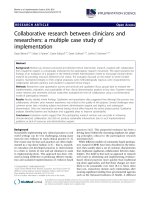Management Accounting And Sensemaking – A Grounded Thory Study Of Maltese Manufacuring Smes
Bạn đang xem bản rút gọn của tài liệu. Xem và tải ngay bản đầy đủ của tài liệu tại đây (1.93 MB, 236 trang )
University of Southampton Research Repository
ePrints Soton
Copyright © and Moral Rights for this thesis are retained by the author and/or other
copyright owners. A copy can be downloaded for personal non-commercial
research or study, without prior permission or charge. This thesis cannot be
reproduced or quoted extensively from without first obtaining permission in writing
from the copyright holder/s. The content must not be changed in any way or sold
commercially in any format or medium without the formal permission of the
copyright holders.
When referring to this work, full bibliographic details including the author, title,
awarding institution and date of the thesis must be given e.g.
AUTHOR (year of submission) "Full thesis title", University of Southampton, name
of the University School or Department, PhD Thesis, pagination
UNIVERSITY OF SOUTHAMPTON
FACULTY OF BUSINESS AND LAW
School of Management
Management accounting and sensemaking - A grounded theory study of Maltese
manufacturing SMEs
by
Francis Debono
Thesis for the degree of Doctor of Philosophy
October 2014
UNIVERSITY OF SOUTHAMPTON
ABSTRACT
FACULTY OF BUSINESS AND LAW
School of Management
Doctor of Philosophy
MANAGEMENT ACCOUNTING AND SENSEMAKING - A GROUNDED
THEORY STUDY OF MALTESE MANUFACTURING SMES
by Francis Debono
This research investigates the role of management accounting within Maltese
manufacturing Small and Medium Sized Enterprises (SMEs). In particular it focuses
on the interaction between users and providers of accounting information. SMEs
make a substantial contribution towards value-added and employment in many of the
major economies and particularly so in a small country like Malta. In spite of their
importance, studies of management accounting practices and processes in this sector
have been rather limited. Taking an Interpretive approach, this research uses Corbin
and Strauss's (2008) Grounded Theory methodology to develop a substantive theory
of how management accounting information becomes significant to SME owners.
The research reveals that in a scenario where Maltese SMEs are facing increased
uncertainty, management accounting information performs an enabling function as it
provides a fundamental input to organisational sensemaking. This process is labelled
'enabling sensemaking through accounting information'. In order for this to take
place, a number of intervening conditions need to be satisfied. First and foremost a
trust threshold needs to be overcome before accountants are allowed to provide the
required information. Then accountants have to make sure that they gain in-depth
knowledge not only of the business functions but also the owners' vision for the
business. Owners on their part need to enable the accountants so that they may
effectively perform their roles.
This research contributes to Interpretive accounting research by extending the
knowledge of the phenomenon of sensemaking in a previously unexplored setting. It
demonstrates how management accounting and sensemaking are interwoven within a
sophisticated framework that requires users and providers of accounting information
to develop a strong personal relationship within SMEs. It also extends the knowledge
of the way in which trust plays a fundamental role in this type of relationship. The
study also serves to extend the applicability of Grounded Theory methodology and
shows how it provides an ideal platform to explore the management accounting
phenomenon as a complex behavioural construct.
i
ii
TABLE OF CONTENTS
ABSTRACT .................................................................................................................. i
TABLE OF CONTENTS ............................................................................................ iii
LIST OF TABLES ...................................................................................................... ix
LIST OF FIGURES .................................................................................................... xi
LIST OF APPENDICES ........................................................................................... xiii
ACKNOWLEDGEMENTS ..................................................................................... xvii
CHAPTER 1 - INTRODUCTION ............................................................................... 1
1.1 Research background ......................................................................................... 1
1.2 Significance of the research ............................................................................... 1
1.3 The underlying theoretical foundation of the research ...................................... 2
1.4 The Maltese scenario.......................................................................................... 3
1.4.1 SMEs in Malta ............................................................................................. 3
1.4.2 The accounting profession in Malta............................................................. 5
1.5 Thesis layout ...................................................................................................... 6
CHAPTER 2 - MANAGEMENT ACCOUNTING IN AN SME SETTING .............. 9
2.1. Introduction ....................................................................................................... 9
2.2 The nature of management accounting ............................................................ 10
2.2.1 Defining management accounting ............................................................. 10
2.2.2 Management accounting and decision-making.......................................... 14
2.2.3 The Relevance of Management Accounting .............................................. 16
2.2.4 The role of the management accountant .................................................... 20
2.2.5 The relationship between accountants and users of accounting information
............................................................................................................................ 21
2.3 Management accounting within SMEs ............................................................ 23
2.3.1 Management accounting research in an SME setting ................................ 23
2.3.2 The introduction and development of management accounting systems in
SMEs................................................................................................................... 25
2.3.3 Management accounting information and SME decision-making ............ 28
2.3.4 Management Accounting and SME performance management and
measurement ....................................................................................................... 30
2.3.5 The role of accountants in SMEs ............................................................... 32
2.3.6 The role of advisors within SMEs ............................................................. 33
iii
2.4 The case for further research in management accounting in SMEs ................. 35
2.5 Conclusion ........................................................................................................ 37
CHAPTER 3 - PARADIGMATIC CHOICES FOR ACCOUNTING RESEARCH 39
3.1 Introduction ...................................................................................................... 39
3.2 Burrell and Morgan's (1979) paradigmatic framework .................................... 39
3.2.1 The philosophy of social science ............................................................... 40
3.2.2 The nature of society .................................................................................. 42
3.2.3 The Four Paradigms ................................................................................... 43
3.3 The Paradigms in Accounting Research .......................................................... 45
3.3.1 Functionalist Research ............................................................................... 46
3.3.2 Interpretive Research ................................................................................. 48
3.3.3 Radical Research ........................................................................................ 50
3.3.4 The paradigms in perspective .................................................................... 52
3.4. Alternatives to Burrell and Morgan ................................................................ 52
3.4.1 Chua's (1986) framework ........................................................................... 52
3.4.2 Laughlin's (1995) framework ..................................................................... 54
3.5 The case for Interpretive accounting research .................................................. 56
3.5.1 The emergence of Interpretive research in accounting .............................. 56
3.5.2 The validity of the Interpretive approach to this study .............................. 60
3.6 Conclusion ........................................................................................................ 61
CHAPTER 4 - RESEARCH METHODOLOGY ...................................................... 63
4.1 Introduction ...................................................................................................... 63
4.2 The choice of a Grounded Theory methodology ............................................. 63
4.3 The Development of Grounded Theory ........................................................... 64
4.3.1 Approach adopted in this study.................................................................. 66
4.4 A Description of Grounded Theory Procedures ............................................... 66
4.4.1 Data collection ........................................................................................... 66
4.4.2 Data analysis - Coding ............................................................................... 67
4.4.3 Memo-writing ............................................................................................ 68
4.5 The emergent theory......................................................................................... 68
4.6 Verifiability and validity .................................................................................. 70
4.7 Potential pitfalls................................................................................................ 70
4.8 Grounded theory in accounting research .......................................................... 71
4.9 Research Design ............................................................................................... 72
iv
4.9.1 Literature Review ...................................................................................... 72
4.9.2 Data collection ........................................................................................... 72
4.9.3 Interviewing approach ............................................................................... 75
4.9.4 Data analysis .............................................................................................. 76
4.9.5 Validity and reliability of findings............................................................. 77
4.10 Summary ........................................................................................................ 78
CHAPTER 5 - OPEN CATEGORIES ....................................................................... 79
5.1 Introduction ...................................................................................................... 79
5.2 Trusting the accountant .................................................................................... 80
5.3 Presenting the information ............................................................................... 82
5.4 Viewing the world differently .......................................................................... 83
5.5 Feeling the pulse .............................................................................................. 85
5.6 Optimising the information .............................................................................. 86
5.7 The value of accounting information ............................................................... 88
5.8 The limitations of accounting information ....................................................... 89
5.9 Raising the alarm.............................................................................................. 91
5.10 Sharing the culture ......................................................................................... 93
5.11 Multiple objectives ......................................................................................... 95
5.12 The importance of accounting information .................................................... 97
5.13 The importance of the accountant .................................................................. 99
5.14 Third party requirements .............................................................................. 101
5.15 Dealing with crises ....................................................................................... 103
5.16 External Changes ......................................................................................... 104
5.17 Internal changes ........................................................................................... 107
5.18 Interaction between users and providers ...................................................... 108
5.19 Communication ............................................................................................ 111
5.20 Trusting the advisor...................................................................................... 113
5.21 Juggling the roles ......................................................................................... 115
5.22 Managing the reporting system .................................................................... 117
5.23 Supporting the provider................................................................................ 119
5.24 Empowering the provider............................................................................. 121
5.25 Users' accounting knowledge ....................................................................... 123
5.26 Accountants' business knowledge ................................................................ 125
5.27 Conclusion ................................................................................................... 127
CHAPTER 6 - AXIAL CATEGORIES ................................................................... 129
v
6.1 Introduction .................................................................................................... 129
6.2 The Code Matrix ............................................................................................ 129
6.3 Aligning the visions ....................................................................................... 131
6.4 Dealing with uncertainty ................................................................................ 133
6.5 Communicating effectively ............................................................................ 135
6.6 Establishing trust ............................................................................................ 138
6.7 Mastering multiple functions ......................................................................... 139
6.8 Enabling the accountant ................................................................................. 141
6.9 Creating actionable information ..................................................................... 143
6.10 Staying close to the action ............................................................................ 144
6.11 Summary ...................................................................................................... 145
CHAPTER 7 - SELECTIVE CODING AND THE EMERGENCE OF THE CORE
CATEGORY ............................................................................................................ 147
7.1 Introduction .................................................................................................... 147
7.2 The paradigm model and the emergence of the core category ....................... 147
7.3 The core category - 'enabling sensemaking through accounting information'150
7.4 The strategies.................................................................................................. 155
7.4.1 Establishing trust ...................................................................................... 155
7.4.2 Obtaining the knowledge ......................................................................... 156
7.4.3 Enabling the accountant ........................................................................... 158
7.4.4 Communicating effectively ...................................................................... 159
7.5 The Conditions ............................................................................................... 160
7.5.1 Macro conditioning factors ...................................................................... 160
7.5.2 Micro conditioning factors ....................................................................... 162
7.5.3 The impact of the contextual factors - dealing with uncertainty ............. 163
7.6 The consequences – Creating actionable information.................................... 163
7.7 Conclusion ...................................................................................................... 165
CHAPTER 8 - THEORETICAL INTEGRATION .................................................. 167
8.1 Introduction .................................................................................................... 167
8.2 An overview of sensemaking research ........................................................... 167
8.3 Sensemaking - a definition ............................................................................. 168
8.3.1 The seven properties of sensemaking ...................................................... 169
8.4 Sensegiving .................................................................................................... 173
8.5 Sensemaking research in accounting.............................................................. 176
8.6 Trust ............................................................................................................... 179
vi
8.6.1 Trust and the external accountant ............................................................ 181
8.6.2 Trust and the internal accountant ............................................................. 182
8.7 Conclusion ..................................................................................................... 184
CHAPTER 9 - CONCLUSION ............................................................................... 187
9.1 Introduction .................................................................................................... 187
9.2 Summary of the main research findings......................................................... 187
9.3 Theoretical and empirical contributions......................................................... 189
9.4 Methodological Contributions ....................................................................... 193
9.5 Suggestions for further research..................................................................... 195
APPENDIX 1 - LIST OF INITIAL OPEN CODES ............................................... 197
REFERENCES......................................................................................................... 199
vii
viii
LIST OF TABLES
Table 1: Thresholds for SME classification ................................................................. 3
Table 2: SMEs in Malta - basic figures ....................................................................... 4
Table 3: Breakdown of interviews ............................................................................. 75
Table 4: Basic interviewing schedule ........................................................................ 76
Table 5: The Code Matrix ........................................................................................ 130
Table 6: Aligning the visions ................................................................................... 131
Table 7: Dealing with uncertainty ............................................................................ 133
Table 8: Communicating effectively........................................................................ 135
Table 9: Establishing trust........................................................................................ 138
Table 10: Mastering multiple functions ................................................................... 139
Table 11: Enabling the accountant ........................................................................... 141
Table 12: Creating actionable information .............................................................. 143
Table 13: Staying close to the action ....................................................................... 144
ix
x
LIST OF FIGURES
Figure 1: The Information Value Chain .................................................................... 12
Figure 2: Uncertainty, decision-making and the roles of accounting practice .......... 14
Figure 3: Manager/management accountant combination and the likelihood of a
perception gap ........................................................................................................... 22
Figure 4: A scheme for analyzing assumptions about the nature of social science ... 42
Figure 5: Four paradigms for the analysis of social theory........................................ 44
Figure 6: Schools of functionalist accounting research ............................................. 46
Figure 7: Dimensions on the choice process for empirical research ......................... 55
Figure 8: Properties and dimensions - Trusting the accountant ................................. 80
Figure 9: Properties and dimensions - Presenting the information ............................ 82
Figure 10: Properties and dimensions - Viewing the world differently ..................... 83
Figure 11: Properties and dimensions - Feeling the pulse ......................................... 85
Figure 12: Properties and dimensions - Optimising the information ......................... 86
Figure 13: Properties and dimensions - The value of accounting information .......... 88
Figure 14: Properties and dimensions - The limitations of accounting information.. 89
Figure 15: Properties and dimensions - Raising the alarm ........................................ 91
Figure 16: Properties and dimensions - Sharing the culture ...................................... 93
Figure 17: Properties and dimensions - Multiple objectives ...................................... 95
Figure 18: Properties and dimensions - The importance of accounting information. 97
Figure 19: Properties and dimensions - The importance of the accountant ............... 99
Figure 20: Properties and dimension - Third party requirements ............................ 101
Figure 21: Properties and dimensions - Dealing with crises .................................... 103
Figure 22: Properties and dimensions - External changes ....................................... 104
Figure 23: Properties and dimensions - Internal changes ........................................ 107
Figure 24: Properties and dimensions - Interaction between users and providers .. 108
Figure 25: Properties and dimensions - Communication ......................................... 111
Figure 26: Properties and dimensions - Trusting the advisor .................................. 113
Figure 27: Properties and dimensions - Juggling the roles ...................................... 115
Figure 28: Properties and dimensions - Managing the reporting system ................. 117
Figure 29: Properties and dimensions - Supporting the provider ............................ 119
Figure 30: Properties and dimensions - Empowering the provider.......................... 121
Figure 31: Properties and dimensions - Users' accounting knowledge .................... 123
Figure 32: Properties and dimensions - Accountants' business knowledge ............. 125
Figure 33: The paradigm model - Enabling sensemaking through accounting
information ............................................................................................................... 154
Figure 34: Four forms or organisational sensemaking ............................................ 175
xi
xii
LIST OF APPENDICES
Appendix 1 - Open concepts to open categories ..................................................... 197
xiii
xiv
ACADEMIC THESIS: DECLARATION OF AUTHORSHIP
I, Francis Debono
declare that this thesis and the work presented in it are my own and has been
generated by me as the result of my own original research.
Management accounting and sensemaking - A grounded theory study of Maltese
manufacturing SMEs
I confirm that:
1. This work was done wholly or mainly while in candidature for a research degree at
this University;
2. Where any part of this thesis has previously been submitted for a degree or any
other qualification at this University or any other institution, this has been clearly
stated;
3. Where I have consulted the published work of others, this is always clearly
attributed;
4. Where I have quoted from the work of others, the source is always given. With the
exception of such quotations, this thesis is entirely my own work;
5. I have acknowledged all main sources of help;
6. Where the thesis is based on work done by myself jointly with others, I have made
clear exactly what was done by others and what I have contributed myself;
7. Either none of this work has been published before submission, or parts of this
work have been published as: [please list references below]:
Signed:
……………………………
Date:
04 October 2014
xv
xvi
ACKNOWLEDGEMENTS
I would like to express my gratitude to my doctoral research supervisors, Professor
Andrew Goddard and Professor Dean Patton for their guidance, insights and
encouragement. I would also like to thank the business owners, accountants,
managers and advisors who managed to find the time in their busy schedules to allow
me to interview them.
xvii
xviii
CHAPTER 1 - INTRODUCTION
1.1 Research background
This research aims to investigate the role of management accounting within Maltese
manufacturing Small and Medium Sized Enterprises (SMEs). In particular this thesis
will look at the interaction between users and providers of accounting information.
SMEs have the potential to make a vital contribution towards economic prosperity
whilst management accounting information can provide the necessary support that
may render SME decision-making more efficient and effective. Accountants, as the
principal providers of accounting information, are thus in a unique position to make
valuable contributions which will improve business performance directly and
national performance indirectly.
In spite of this potential, in-depth studies of management accounting practices and
process in SMEs have been limited. This research will try to address this lacuna and
contribute to the academic body of knowledge on this subject area. The specific aim
is to develop a theory which can explain the processes underlying the use of
management accounting information in the context of Maltese manufacturing SMEs.
The research does not aim to explore any specific management accounting
techniques as such. Rather, by looking at the management accounting phenomenon
across several businesses this thesis will propose a grounded substantive theory of
how accounting information becomes significant to users irrespective of the
management accounting tools used. The focus will therefore be on the social
processes that render management accounting information relevant.
1.2 Significance of the research
The aim of this research is to contribute to existent academic knowledge of
management accounting processes in practice. By engaging with the empirical world
of management accounting practice it will not only provide theoretical insights
valuable for academic researchers but also provide a concrete platform which can be
1
used by researchers to establish a fruitful dialogue with accounting and management
practitioners.
Within the European Union (EU), SMEs account for 99% of all businesses. Between
them they employ approximately two-thirds of all private sector employees and
generate over half of value-added contributed by all businesses (European
Commission, online.). They can thus be considered to be the "true back-bone of the
European economy, being primarily responsible for wealth and economic growth,
next to their key role in innovation and R&D" (European Commission, online.).
Therefore the more that is known about how they use accounting information, the
more can be done to provide them with the kind of accounting information they need.
The challenges being faced by businesses can have a significant impact on the use of
management accounting information. This will in turn have an impact on the
interaction between those who provide and those who use that information. This
makes this research particularly significant given the economic environment being
faced at the time of this study (2010-2014).
1.3 The underlying theoretical foundation of the research
This research focuses on the social processes and interactions relating to
management accounting that take place in an organisational setting. It is thus firmly
rooted within the Interpretive approach to accounting research. This sees accounting
as a social phenomenon that is created and interpreted by the actors involved. The
meaning and mode of utilisation of accounting information is not absolute but
relative to the individual, organisational and environmental influences. It is by
exploring these influences that researchers can achieve a deeper understanding of
how accounting information becomes meaningful.
The research strategy follows the principles of Grounded Theory (Glaser and Strauss,
1967, Strauss and Corbin, 1998, Corbin and Strauss, 2008). This approach allows for
issues that are relevant to the research participants to emerge from the participants
themselves. It therefore ensures that their interpretation of the phenomenon is
2
captured. Grounded Theory supports the Interpretive stance discussed in the previous
paragraph and facilitates the generation of theories that are transferable between
different audiences.
1.4 The Maltese scenario
1.4.1 SMEs in Malta
SMEs are defined by the European Commission (2003) as companies that satisfy the
following thresholds with regards to number of employees and turnover or balance
sheet total:
Balance
Employees Turnover or sheet
total
Medium-sized < 250
€ 50 m
€ 43 m
Small
< 50
€ 10 m
€ 10 m
Micro
< 10
€2m
€2m
Company
category
Table 1: Thresholds for SME classification (European Commission, 2003)
In terms of business size, the economic structure of Malta is similar to that found in
the EU indicated in section 1.2. However, the reliance of the Maltese economy on the
contribution of the SME sector is even more pronounced than for the rest of the EU
(European Commission, 2013). In Malta, SMEs generate 80% of employment,
compared to the EU average of 66.5% and 71.4% of value-added compared to the
EU average of 57.6%. This gap is expected to widen further in the coming years
(European Commission, 2013). The SMEs have had a crucial role in enabling Malta
to weather the economic crisis reasonably well with employment within this sector
increasing by 2.5% in the period 2008-12 (European Commission, 2013). During the
same period, manufacturing SMEs in particular outperformed large businesses both
in terms of employment levels (an increase of 2% against a reduction of 6%) and
value added (an increase of 3% versus a reduction of 13%). Together with wholesale
and retail trade, manufacturing contributes to more than 46% of both employment
and value-added within the SME sector (European Commission, 2013). Table 2
below provides a summary of this data:
3
Number of enterprises
Malta
Number
Share
Number of employees
EU27
Malta
Share
Number
Share
Value Added
EU27
Malta
Share
Billion €
EU27
Share
Share
Micro
24,837
94.1%
92.1%
41,660
36.0%
28.7%
1
29.1%
21.1%
Small
1,244
4.7%
6.6%
25,100
21.7%
20.4%
1
21.6%
18.3%
265
1.0%
1.1%
25,942
22.4%
17.3%
1
20.6%
18.3%
SMEs
26,346
99.8%
99.8%
92,702
80.0%
66.5%
2
71.4%
57.6%
Large
45
0.2%
0.2%
23,126
20.0%
33.5%
1
28.6%
42.4%
26,391
100.0%
100.0%
115,828
100.0%
100.0%
3
100.0%
100.0%
Mediumsized
Total
Table 2: SMEs in Malta - basic figures (European Commission, 2103, p.2)
Maltese manufacturing companies that produce mainly for the local market have had
a long history of government protection. Import restrictions, import duties and quota
systems ensured that these companies had a ready market for their product with
limited external competition. Moreover further controls on the operation of the
market within Malta meant that competition between rival firms producing for local
consumption was also rather mild. When Malta joined the EU in 2004 this
protective/regulatory regime was gradually removed over a period of several years.
This had a major impact on most of these businesses and the Maltese government
had to spend considerable effort in assisting these businesses to face the new reality.
The dismantling of protective measures has driven the SMEs towards higher levels
of capital investment as they seek to become leaner and increase the value-added
content of their output. Moreover they are moving towards a more specialised human
resource requirement which in turn triggers further investment in staff training and
development (Ernst & Young, 2013).
The small size of the Maltese market presents a number of special challenges for
Maltese SMEs. The deregulated domestic market is very small meaning that it tends
to be dominated by a few firms which compete very intensively amongst themselves.
New entrants will find it very difficult to break into this market (Ernst & Young,
4
2013). The small size also allows limited opportunities to take advantage of
economies of scale. Manufacturing firms in particular will find that even minimum
orders from suppliers exceed their requirements and end up carrying very high level
of stocks which puts a substantial strain on their financing requirements (Ernst &
Young, 2013).
Financing options are also limited as the small size of the economy means that the
capital market is likewise constrained. There are no venture capital structures and
investment banks consider the local economy too small to provide a local service
(Ernst & Young, 2013). Thus SMEs have to rely almost exclusively on loan
financing through the main local banks. However since these are essentially
commercial banks they impose a substantial collateral burden and charge higher
interest rates (Ernst & Young, 2013).
The geographic isolation of Malta, a group of islands in the middle of the
Mediterranean Sea without permanent land connections, creates a number of unique
challenges for manufacturing businesses. Transport costs are necessarily higher and
this inflates the production costs, which in turn lead to higher prices for consumers
(Ernst & Young, 2013). The main transport link is via marine transport. This means
that re-supply is subject to delays and unreliable delivery schedules caused by natural
phenomena (Ernst & Young, 2013).
1.4.2 The accounting profession in Malta
Malta has a very well established accounting profession. With almost 2,000 fully
qualified accountants (Accountancy Board, 2014) it represents a sizable portion of
the approximately 165,000 (National Statistics Office, 2014) gainfully occupied
persons in Malta. Several routes are available for Maltese citizens to qualify as
accountants, the main two being the five-year course at the University of Malta and
the UK qualification provided by the Association of Chartered and Certified
Accountants (ACCA). At any one time there are approximately 1,000 individuals
pursuing professional accountancy studies. All first tier and many mid-tier
5









